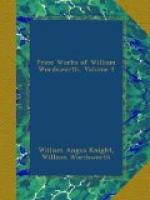The last I saw was on the wing, off the promontory of Fairhead, county of Antrim. I mention this, because, though my tour in Ireland, with Mr. Marshall and his son, was made many years ago, this allusion to the eagle is the only image supplied by it to the poetry I have since written. We travelled through the country in October; and to the shortness of the days, and the speed with which we travelled (in a carriage-and-four), may be ascribed this want of notices, in my verse, of a country so interesting. The deficiency I am somewhat ashamed of, and it is the more remarkable, as contrasted with my Scotch and continental tours, of which are to be found in these volumes so many memorials.
370. *_In the Sound of Mull_. [X.]
Touring late in the season in Scotland is an uncertain speculation. We were detained a week by rain at Bunaw, on Loch Etive, in a vain hope that the weather would clear up, and allow me to show my daughter the beauties of Glencoe. Two days we were at the Isle of Mull, on a visit to Major Campbell; but it rained incessantly, and we were obliged to give up our intention of going to Staffa. The rain pursued us to Tyndrum, where the next sonnet was composed in a storm.
371. ‘Shepherds of Etive Glen.’ [X.]
In Gaelic—Buachaill Eite.
372. Highland Broach. [XV.]
On ascending a hill that leads from Loch Awe towards Inverary, I fell into conversation with a woman of the humbler class, who wore one of these Highland broaches. I talked with her about it, and upon parting with her, when I said, with a kindness I truly felt, ’May the broach continue in your family for many generations to come, as you have already possessed it,’ she thanked me most becomingly, and seemed not a little moved. The exact resemblance which the old broach (still in use, though rarely met with among the Highlanders) bears to the Roman Fibula must strike every one, and concurs, with the plaid and kilt, to recall to mind the communication which the ancient Romans had with this remote country.
[Note.—How much the Broach is sometimes prized by persons in humble stations may be gathered from an occurrence mentioned to me by a female friend. She had an opportunity of benefiting a poor old woman in her own hut, who, wishing to make a return, said to her daughter in Erse, in a tone of plaintive earnestness, ’I would give anything I have, but I hope she does not wish for my Broach!’ and uttering these words she put her hand upon the Broach which fastened her kerchief, and which she imagined had attracted the eye of her benefactress.]
373. The Brownie. [XVI.]
Upon a small island not far from the head of Loch Lomond, are some remains of an ancient building, which was for several years the abode of a solitary Individual, one of the last survivors of the clan of Macfarlane, once powerful in that neighbourhood. Passing along the shore opposite this island in the year 1814, the Author learned these particulars, and that this person then living there had acquired the appellation of ‘The Brownie.’ See ‘The Brownie’s Cell’ [’Memorials of a Tour in Scotland, 1814,’ I.], to which the following is a sequel.




